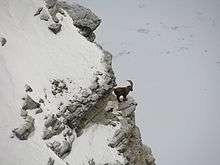Sure-footedness
Sure-footedness refers to the ability, especially when hiking or mountain climbing, to negotiate difficult or rough terrain safely. Such situations place demands on a person's coordination and reserves of strength as well as requiring sufficient appreciation of the terrain. A person who is sure-footed is thus unlikely to slip or stumble.[1]
On many hiking trails and mountain tours, sure-footedness is assumed to be a prerequisite without ever being defined. The term is frequently used in the literature presumably to ensure that the reader is made sufficiently aware that, under certain circumstances, one false step may lead to serious consequences.[2]
Required attributes
Although there is no standard definition of sure-footedness,[2] the following is a list of attributes that, as a rule, constitute what is generally meant:
- Possession of sufficient coordination to progress over uneven ground as intended, without losing one's balance. That also includes being able to compensate for small slips when moving forward, without any serious consequences.
- Correct assessment of the ground, both in terms of usable footholds or steps and also the level of grip they afford. One must be able to do this on all types of terrain, including scree, rock, schrofen, bare earth or firn, and also in wet conditions.[2]
- An ability to recognise those parts of the route which need to be negotiated with particular care due to the risk of falling.
- Proper assessment of one's own level of coordination and ability, even when tired, in order to adjust one's rate of progress accordingly. Experience has shown that sure-footedness decreases in the afternoon due to physical and mental fatigue.
Limitation

The requirement for sure-footedness is usually only mentioned when speaking about routes on which no special climbing ability is required. It is also not necessarily the case that someone with climbing experience is automatically sure-footed. Nor does sure-footedness imply a head for heights, something that is often stated as a requirement for using mountain paths. In this context, a head for heights means having the ability to negotiate exposed sections of a route without feeling unduly frightened. However, it is no accident that both requirements are often referred to together because, on exposed routes, the consequences of falling are likely to be serious.
Training
Sure-footedness is something that one can be trained in to a certain extent, especially through regular, strenuous exercise in steep, rough terrain that is not exposed. In the early phases hiking sticks can be helpful. However, too great a reliance on them can be detrimental to sure-footedness when crossing terrain where they are of no use—as for example on protected rock sections. On the other hand, hiking poles can be invaluable, especially for older hikers, and those with knee problems, and as well provide added security where a stumble might be hazardous, on uneven ground or an exposed path.
Animal sure-footedness

The term sure-footedness is also used to describe animals that operate in difficult terrain and is seen as a characteristic, especially of goats and certain breeds of horse. Occasionally animals such as dogs are described as sure-footed. Yaks are used on climbing and trekking expeditions in the Himalayas because of their ability both as pack animals and sure-footedness.
References
- Soanes, Catherine and Stevenson, Angus (ed.) (2005). Oxford Dictionary of English, 2nd Ed., revised, Oxford University Press, Oxford, New York, p. 1775. ISBN 978-0-19-861057-1.
- Was ist Trittsicherheit?" by Csaba Szepfalusi, Edelweiss Zeitung, Issue 4, 2003, pp 6-7 at www.oeav-events.at. Retrieved 1 Jun 2014.
Literature
- DAV Panorama, Mitteilungen des Deutschen Alpenvereins, No 3. 2006, pp. 92–95, ISSN 1437-5923